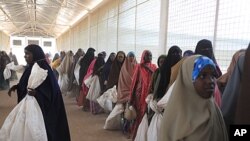Thousands of Somali refugees are continuing to pour into Kenya's Dadaab refugee camps. But as they flee hardships at home, they face new challenges at the overstretched facilities.
Dahabo Salat is a 22-year-old refugee from Somalia. She is one of 300 new arrivals, waiting outside the gates of Dagahely camp - one of the three Kenyan refugee camps accepting Somalians fleeing drought and violence.
Like many others here, she comes from a farming family. She decided to head here to Dadaab, with her two children, after all of her livestock died from the drought. She expects her husband to make the long journey in the coming days.
“Here we expect to be given food, where we came from we could not afford food. We were pastoralists and we lost everything,” she said.
Salat is taken into the camp and given a new pair of sandals, a medical screening for her family and two week's worth of flour, cornmeal, beans and oil.
She and other refugees are even greeted warmly by a group of local Somali youths and religious leaders who welcome new arrivals.
Some are also camp residents.
Osman Barre, one of the organizers of this unofficial welcoming committee, arrived at the Dadaab camps in 1992, when he was just a child. “When they see their fellow Somali people receiving them at reception they also feel that they are being taken care of they also feel that they are part of the Somali community,” he said.
Refugees come to the camps not only as a place to seek shelter, but as a chance for opportunities they could not get at home. They can receive health care and their children can go to school.
And life inside the camp is not unlike small-town life outside. There are shops selling mobile phones, restaurants and hotels. It feels like a small village.
But Dadaab is getting more crowded with 1,200 new arrivals a day and it is running out of room.
So, like 70,000 others, new arrivals are being pushed to the outskirts of the camp.
On the dusty, windswept plain outside of Dagehely camp, thousands of people have set up temporary shelters - huts, mostly, held together with discarded tarps and bags marked with the logos of various United Nations agencies.
The people out here live illegally, on Kenyan government land, fending for themselves outside the reach of most of the non-governmental organizations providing aid.
Abukar Mukhtar made the journey here in June but he was not able to register with the camp, because of a riot that broke out that day over food.
Because he has not registered, he does not have a food ration card and cannot get the weekly food supply. So he begs from other refugees at the market in Dagehely.
He says “We were helped by relatives who know this place and they brought us here; when we don’t have anything to eat they will bring us food.”
The camps were originally built to hold 90,000 people and are now home to about 400,000.
The Kenyan prime minister, Raila Odinga, has said the government will provide more camp space but that will take time.
With no early end in sight for the drought and the ongoing political turmoil in Somalia, international organizations are appealing for more help providing for those who have been pushed to the outskirts.













